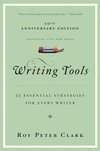
Saved by Tyler and
Writing Tools: 55 Essential Strategies for Every Writer

Saved by Tyler and
You will find in this toolbox new ways of thinking, along with many familiar pieces of advice, dusted off and reframed for a new century. But where do writing tools come from?
Read Lincoln’s Gettysburg Address and Dr. Martin Luther King Jr.’s “I Have a Dream” speech and study emphatic word order. 2. With a pencil in hand, read an essay you admire. Circle the first and last words in each paragraph. 3. Do the same for recent examples of your work. Revise sentences so that powerful and interesting words, which may be hiding
... See moreforms with a pencil. In the margins, categorize each verb. 2. Convert passive and to be verbs into the active. For example, “It was her observation that” can become “She observed.” 3. In your own work and in the newspaper, search for verb qualifiers and see what happens when you cut them. 4. Experiment with both voice and tense. Find a passage you
... See moreScrape away these crustaceans during revision, and the ship of your prose will glide toward meaning with speed and grace.
Strong verbs create action, save words, and reveal the players.
Use the long sentence to describe something long. Let form follow function.
That’s the writing tool: use passive verbs to call attention to the receiver of the action.
Writing long sentences means going against the grain. But isn’t that what the best writers do? In his novel The Rings of Saturn, W. G. Sebald uses the long sentence to explain—and mirror—the antique prose style of English essayist Sir Thomas Browne: In common with other English writers of the seventeenth century, Browne wrote out of the fullness of
... See moreBegin with a good quote. Hide the attribution in the middle. End with a good quote.